Impact Analysis: Evaluating a Car-Free City Center
VerifiedAdded on 2023/06/16
|11
|3341
|331
Report
AI Summary
This report examines the multifaceted impacts of implementing a car-free city center, addressing economic, social, and environmental dimensions. It highlights the adverse effects of car reliance, including air pollution, traffic congestion, and societal impacts, while exploring potential benefits such as reduced pollution, improved public health, and boosted local business. The analysis covers the impact on employment, taxpayer costs, and business operations, as well as the environmental implications related to carbon footprint, pollution levels, and construction activities. Furthermore, it delves into the social impacts, considering public response, demographic shifts, and changes in crime rates. The report concludes by offering recommendations for managing the transition to a car-free city, emphasizing the importance of collaboration between municipalities and businesses to ensure successful implementation and address potential challenges. Desklib provides access to similar reports and resources for students.

Car free city
Paraphrase This Document
Need a fresh take? Get an instant paraphrase of this document with our AI Paraphraser
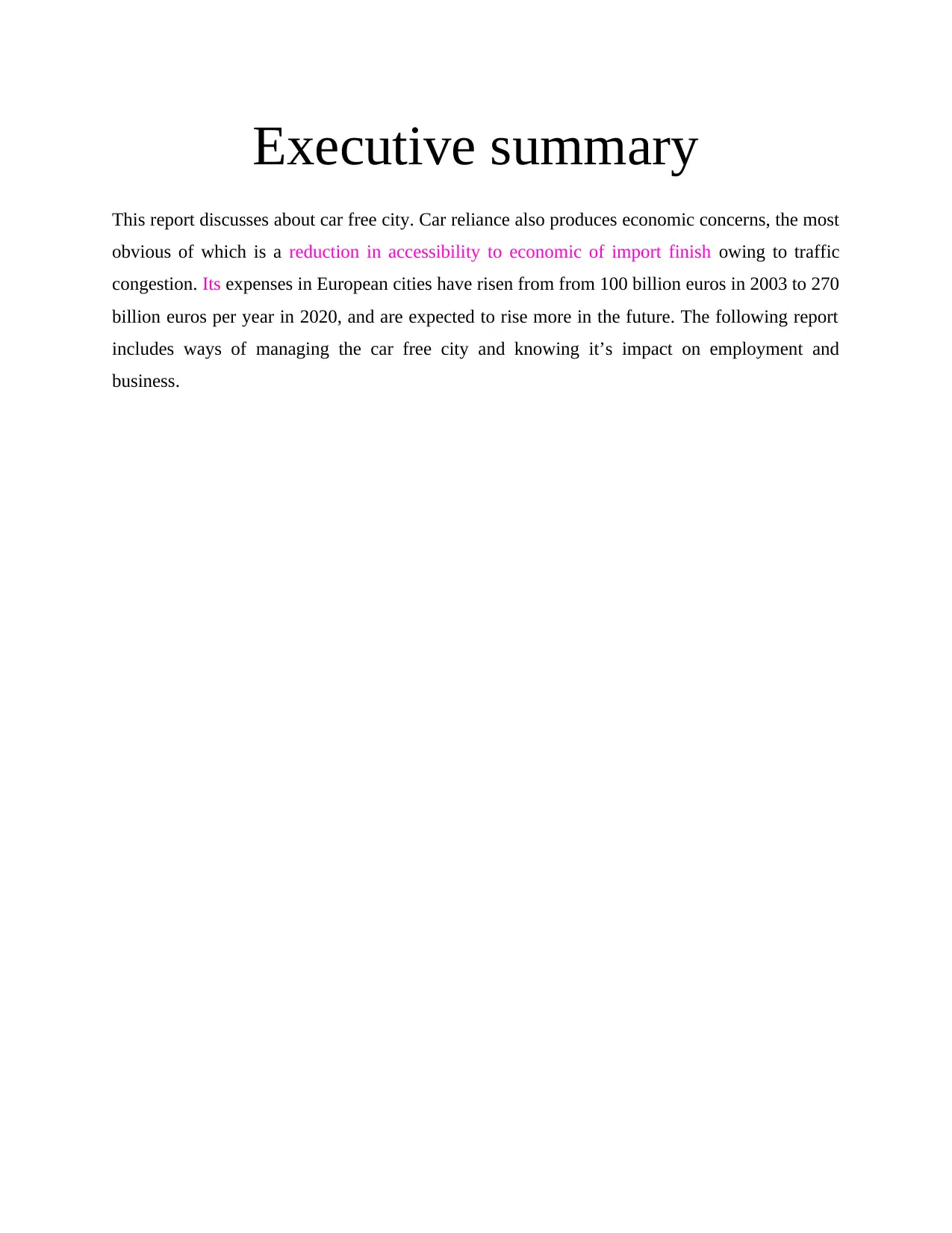
Executive summary
This report discusses about car free city. Car reliance also produces economic concerns, the most
obvious of which is a reduction in accessibility to economic of import finish owing to traffic
congestion. Its expenses in European cities have risen from from 100 billion euros in 2003 to 270
billion euros per year in 2020, and are expected to rise more in the future. The following report
includes ways of managing the car free city and knowing it’s impact on employment and
business.
This report discusses about car free city. Car reliance also produces economic concerns, the most
obvious of which is a reduction in accessibility to economic of import finish owing to traffic
congestion. Its expenses in European cities have risen from from 100 billion euros in 2003 to 270
billion euros per year in 2020, and are expected to rise more in the future. The following report
includes ways of managing the car free city and knowing it’s impact on employment and
business.
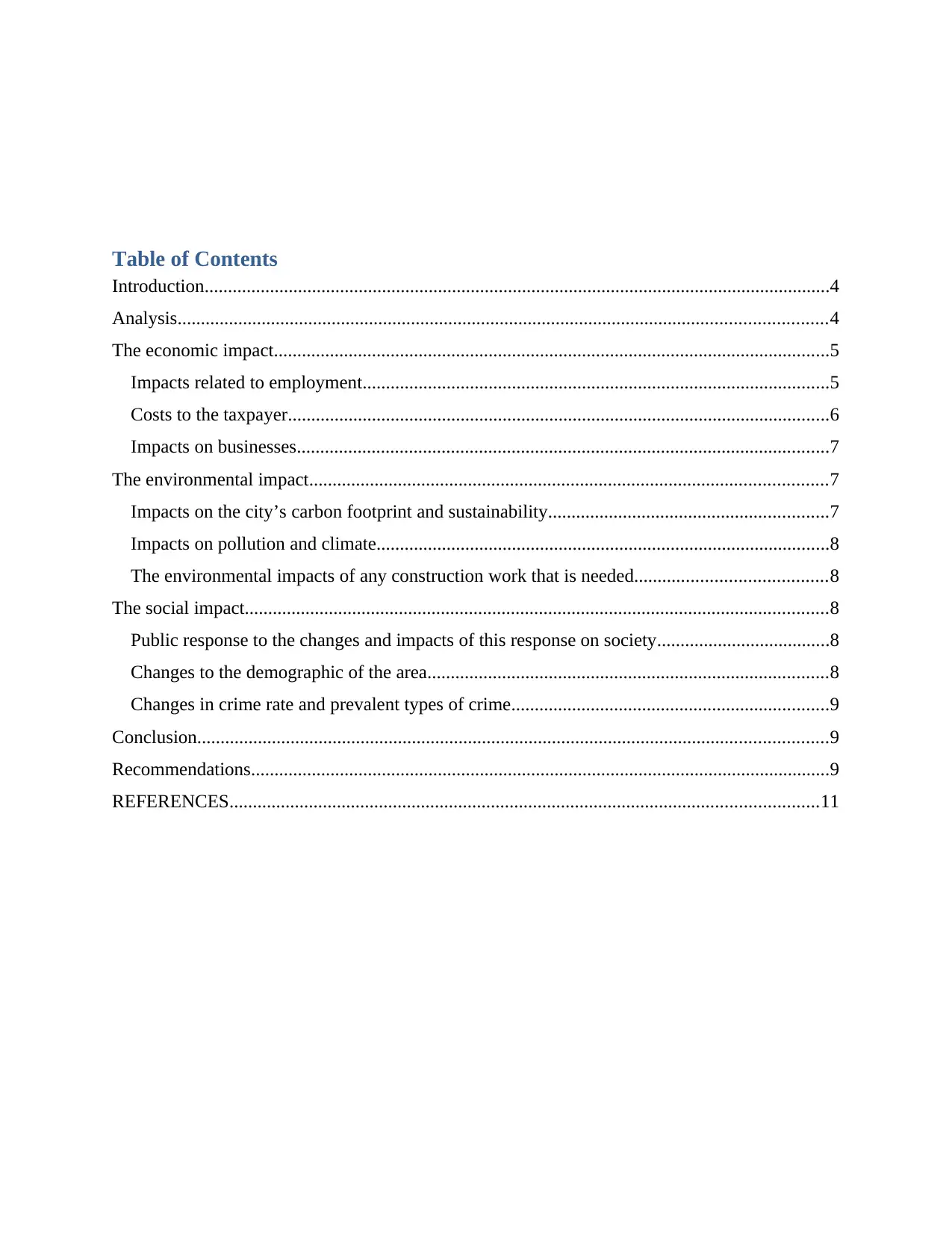
Table of Contents
Introduction......................................................................................................................................4
Analysis...........................................................................................................................................4
The economic impact.......................................................................................................................5
Impacts related to employment....................................................................................................5
Costs to the taxpayer....................................................................................................................6
Impacts on businesses..................................................................................................................7
The environmental impact...............................................................................................................7
Impacts on the city’s carbon footprint and sustainability............................................................7
Impacts on pollution and climate.................................................................................................8
The environmental impacts of any construction work that is needed.........................................8
The social impact.............................................................................................................................8
Public response to the changes and impacts of this response on society.....................................8
Changes to the demographic of the area......................................................................................8
Changes in crime rate and prevalent types of crime....................................................................9
Conclusion.......................................................................................................................................9
Recommendations............................................................................................................................9
REFERENCES..............................................................................................................................11
Introduction......................................................................................................................................4
Analysis...........................................................................................................................................4
The economic impact.......................................................................................................................5
Impacts related to employment....................................................................................................5
Costs to the taxpayer....................................................................................................................6
Impacts on businesses..................................................................................................................7
The environmental impact...............................................................................................................7
Impacts on the city’s carbon footprint and sustainability............................................................7
Impacts on pollution and climate.................................................................................................8
The environmental impacts of any construction work that is needed.........................................8
The social impact.............................................................................................................................8
Public response to the changes and impacts of this response on society.....................................8
Changes to the demographic of the area......................................................................................8
Changes in crime rate and prevalent types of crime....................................................................9
Conclusion.......................................................................................................................................9
Recommendations............................................................................................................................9
REFERENCES..............................................................................................................................11
⊘ This is a preview!⊘
Do you want full access?
Subscribe today to unlock all pages.

Trusted by 1+ million students worldwide
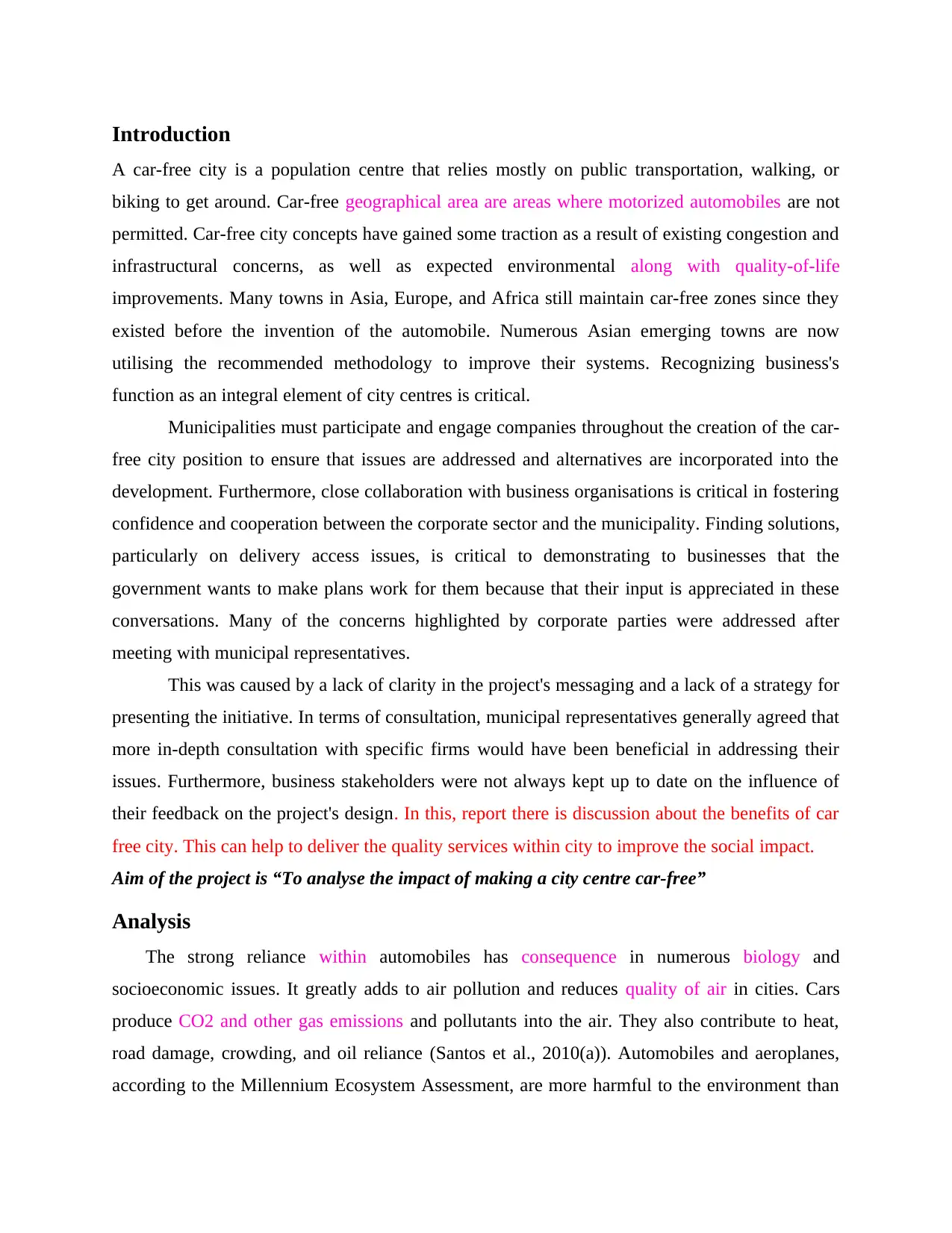
Introduction
A car-free city is a population centre that relies mostly on public transportation, walking, or
biking to get around. Car-free geographical area are areas where motorized automobiles are not
permitted. Car-free city concepts have gained some traction as a result of existing congestion and
infrastructural concerns, as well as expected environmental along with quality-of-life
improvements. Many towns in Asia, Europe, and Africa still maintain car-free zones since they
existed before the invention of the automobile. Numerous Asian emerging towns are now
utilising the recommended methodology to improve their systems. Recognizing business's
function as an integral element of city centres is critical.
Municipalities must participate and engage companies throughout the creation of the car-
free city position to ensure that issues are addressed and alternatives are incorporated into the
development. Furthermore, close collaboration with business organisations is critical in fostering
confidence and cooperation between the corporate sector and the municipality. Finding solutions,
particularly on delivery access issues, is critical to demonstrating to businesses that the
government wants to make plans work for them because that their input is appreciated in these
conversations. Many of the concerns highlighted by corporate parties were addressed after
meeting with municipal representatives.
This was caused by a lack of clarity in the project's messaging and a lack of a strategy for
presenting the initiative. In terms of consultation, municipal representatives generally agreed that
more in-depth consultation with specific firms would have been beneficial in addressing their
issues. Furthermore, business stakeholders were not always kept up to date on the influence of
their feedback on the project's design. In this, report there is discussion about the benefits of car
free city. This can help to deliver the quality services within city to improve the social impact.
Aim of the project is “To analyse the impact of making a city centre car-free”
Analysis
The strong reliance within automobiles has consequence in numerous biology and
socioeconomic issues. It greatly adds to air pollution and reduces quality of air in cities. Cars
produce CO2 and other gas emissions and pollutants into the air. They also contribute to heat,
road damage, crowding, and oil reliance (Santos et al., 2010(a)). Automobiles and aeroplanes,
according to the Millennium Ecosystem Assessment, are more harmful to the environment than
A car-free city is a population centre that relies mostly on public transportation, walking, or
biking to get around. Car-free geographical area are areas where motorized automobiles are not
permitted. Car-free city concepts have gained some traction as a result of existing congestion and
infrastructural concerns, as well as expected environmental along with quality-of-life
improvements. Many towns in Asia, Europe, and Africa still maintain car-free zones since they
existed before the invention of the automobile. Numerous Asian emerging towns are now
utilising the recommended methodology to improve their systems. Recognizing business's
function as an integral element of city centres is critical.
Municipalities must participate and engage companies throughout the creation of the car-
free city position to ensure that issues are addressed and alternatives are incorporated into the
development. Furthermore, close collaboration with business organisations is critical in fostering
confidence and cooperation between the corporate sector and the municipality. Finding solutions,
particularly on delivery access issues, is critical to demonstrating to businesses that the
government wants to make plans work for them because that their input is appreciated in these
conversations. Many of the concerns highlighted by corporate parties were addressed after
meeting with municipal representatives.
This was caused by a lack of clarity in the project's messaging and a lack of a strategy for
presenting the initiative. In terms of consultation, municipal representatives generally agreed that
more in-depth consultation with specific firms would have been beneficial in addressing their
issues. Furthermore, business stakeholders were not always kept up to date on the influence of
their feedback on the project's design. In this, report there is discussion about the benefits of car
free city. This can help to deliver the quality services within city to improve the social impact.
Aim of the project is “To analyse the impact of making a city centre car-free”
Analysis
The strong reliance within automobiles has consequence in numerous biology and
socioeconomic issues. It greatly adds to air pollution and reduces quality of air in cities. Cars
produce CO2 and other gas emissions and pollutants into the air. They also contribute to heat,
road damage, crowding, and oil reliance (Santos et al., 2010(a)). Automobiles and aeroplanes,
according to the Millennium Ecosystem Assessment, are more harmful to the environment than
Paraphrase This Document
Need a fresh take? Get an instant paraphrase of this document with our AI Paraphraser
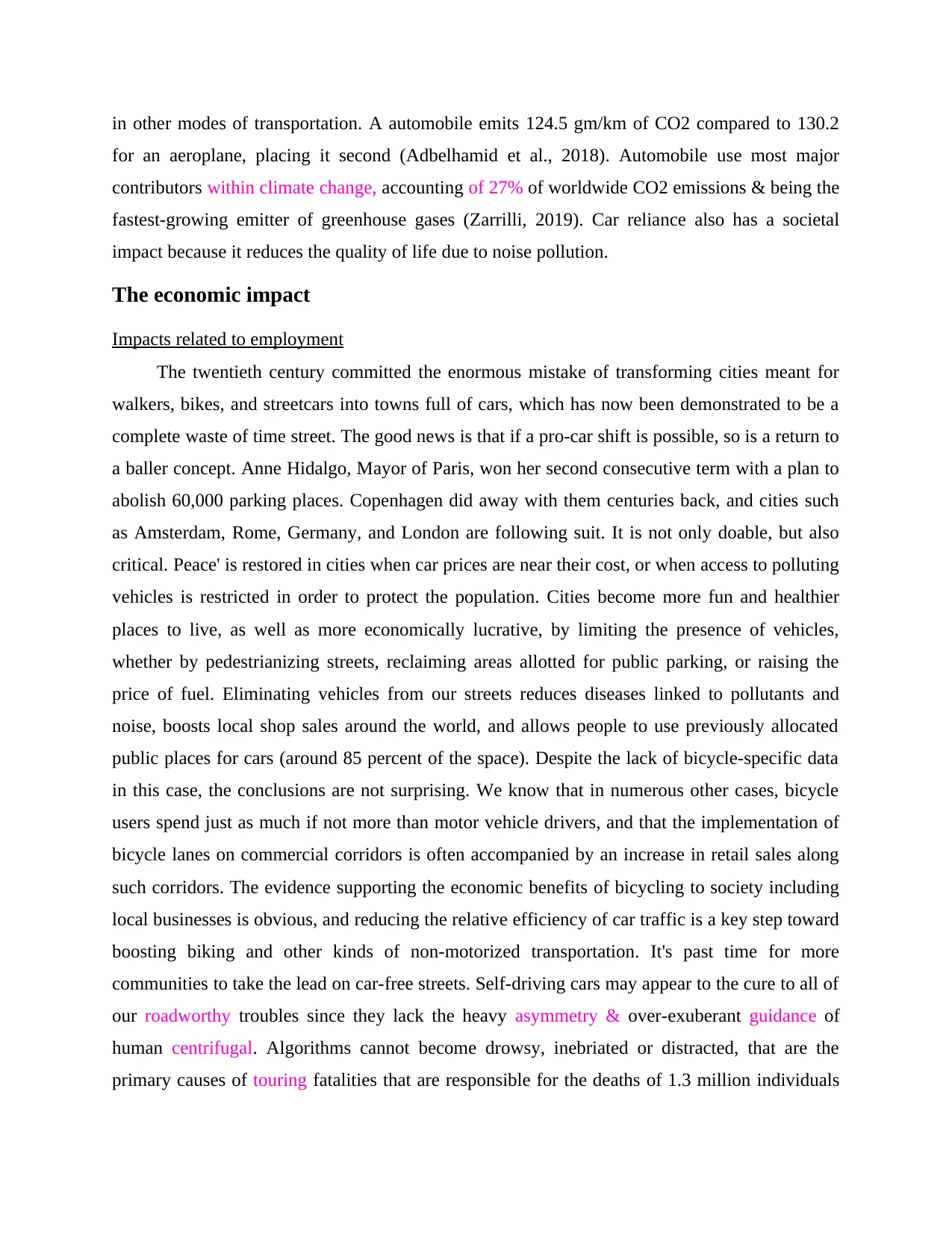
in other modes of transportation. A automobile emits 124.5 gm/km of CO2 compared to 130.2
for an aeroplane, placing it second (Adbelhamid et al., 2018). Automobile use most major
contributors within climate change, accounting of 27% of worldwide CO2 emissions & being the
fastest-growing emitter of greenhouse gases (Zarrilli, 2019). Car reliance also has a societal
impact because it reduces the quality of life due to noise pollution.
The economic impact
Impacts related to employment
The twentieth century committed the enormous mistake of transforming cities meant for
walkers, bikes, and streetcars into towns full of cars, which has now been demonstrated to be a
complete waste of time street. The good news is that if a pro-car shift is possible, so is a return to
a baller concept. Anne Hidalgo, Mayor of Paris, won her second consecutive term with a plan to
abolish 60,000 parking places. Copenhagen did away with them centuries back, and cities such
as Amsterdam, Rome, Germany, and London are following suit. It is not only doable, but also
critical. Peace' is restored in cities when car prices are near their cost, or when access to polluting
vehicles is restricted in order to protect the population. Cities become more fun and healthier
places to live, as well as more economically lucrative, by limiting the presence of vehicles,
whether by pedestrianizing streets, reclaiming areas allotted for public parking, or raising the
price of fuel. Eliminating vehicles from our streets reduces diseases linked to pollutants and
noise, boosts local shop sales around the world, and allows people to use previously allocated
public places for cars (around 85 percent of the space). Despite the lack of bicycle-specific data
in this case, the conclusions are not surprising. We know that in numerous other cases, bicycle
users spend just as much if not more than motor vehicle drivers, and that the implementation of
bicycle lanes on commercial corridors is often accompanied by an increase in retail sales along
such corridors. The evidence supporting the economic benefits of bicycling to society including
local businesses is obvious, and reducing the relative efficiency of car traffic is a key step toward
boosting biking and other kinds of non-motorized transportation. It's past time for more
communities to take the lead on car-free streets. Self-driving cars may appear to the cure to all of
our roadworthy troubles since they lack the heavy asymmetry & over-exuberant guidance of
human centrifugal. Algorithms cannot become drowsy, inebriated or distracted, that are the
primary causes of touring fatalities that are responsible for the deaths of 1.3 million individuals
for an aeroplane, placing it second (Adbelhamid et al., 2018). Automobile use most major
contributors within climate change, accounting of 27% of worldwide CO2 emissions & being the
fastest-growing emitter of greenhouse gases (Zarrilli, 2019). Car reliance also has a societal
impact because it reduces the quality of life due to noise pollution.
The economic impact
Impacts related to employment
The twentieth century committed the enormous mistake of transforming cities meant for
walkers, bikes, and streetcars into towns full of cars, which has now been demonstrated to be a
complete waste of time street. The good news is that if a pro-car shift is possible, so is a return to
a baller concept. Anne Hidalgo, Mayor of Paris, won her second consecutive term with a plan to
abolish 60,000 parking places. Copenhagen did away with them centuries back, and cities such
as Amsterdam, Rome, Germany, and London are following suit. It is not only doable, but also
critical. Peace' is restored in cities when car prices are near their cost, or when access to polluting
vehicles is restricted in order to protect the population. Cities become more fun and healthier
places to live, as well as more economically lucrative, by limiting the presence of vehicles,
whether by pedestrianizing streets, reclaiming areas allotted for public parking, or raising the
price of fuel. Eliminating vehicles from our streets reduces diseases linked to pollutants and
noise, boosts local shop sales around the world, and allows people to use previously allocated
public places for cars (around 85 percent of the space). Despite the lack of bicycle-specific data
in this case, the conclusions are not surprising. We know that in numerous other cases, bicycle
users spend just as much if not more than motor vehicle drivers, and that the implementation of
bicycle lanes on commercial corridors is often accompanied by an increase in retail sales along
such corridors. The evidence supporting the economic benefits of bicycling to society including
local businesses is obvious, and reducing the relative efficiency of car traffic is a key step toward
boosting biking and other kinds of non-motorized transportation. It's past time for more
communities to take the lead on car-free streets. Self-driving cars may appear to the cure to all of
our roadworthy troubles since they lack the heavy asymmetry & over-exuberant guidance of
human centrifugal. Algorithms cannot become drowsy, inebriated or distracted, that are the
primary causes of touring fatalities that are responsible for the deaths of 1.3 million individuals
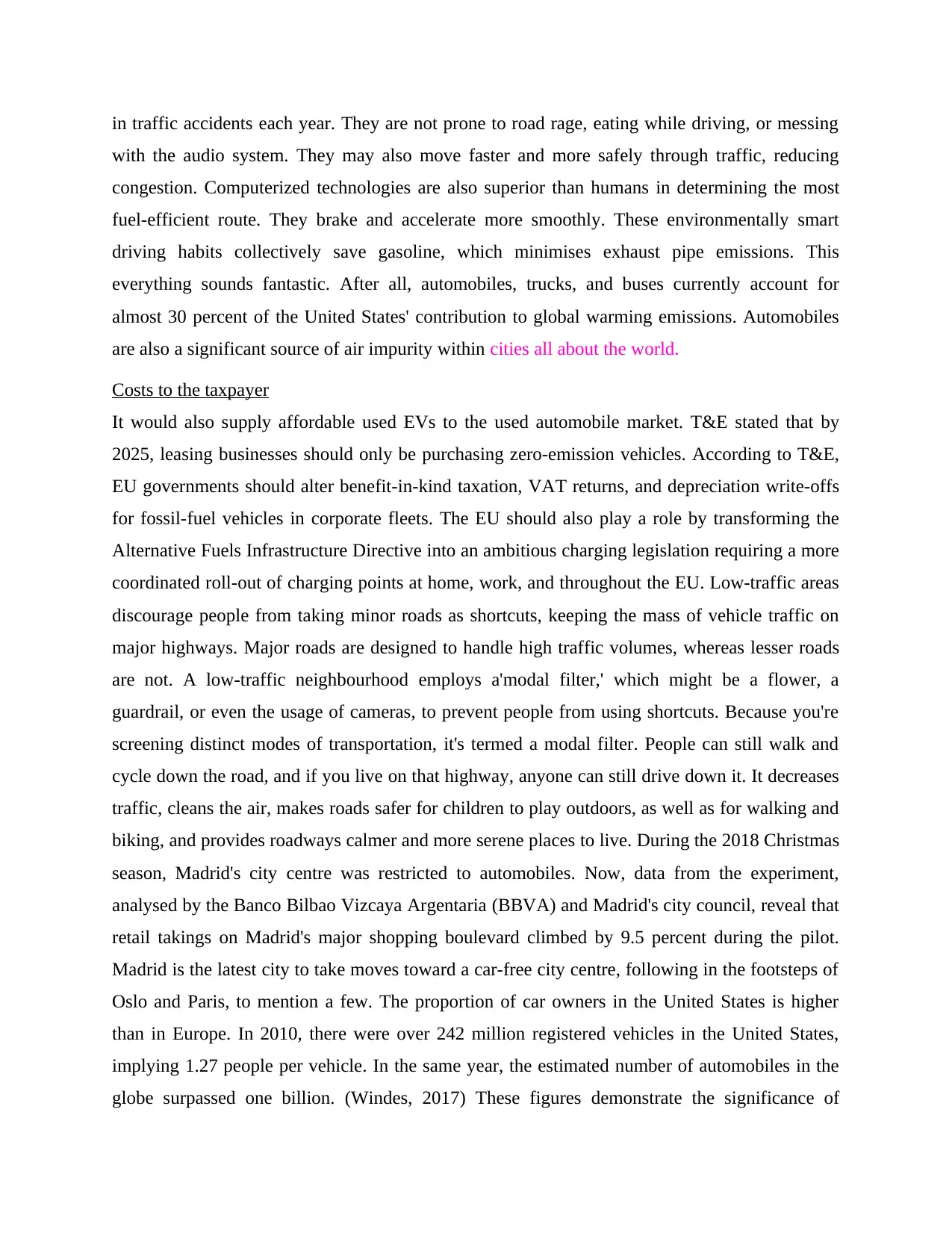
in traffic accidents each year. They are not prone to road rage, eating while driving, or messing
with the audio system. They may also move faster and more safely through traffic, reducing
congestion. Computerized technologies are also superior than humans in determining the most
fuel-efficient route. They brake and accelerate more smoothly. These environmentally smart
driving habits collectively save gasoline, which minimises exhaust pipe emissions. This
everything sounds fantastic. After all, automobiles, trucks, and buses currently account for
almost 30 percent of the United States' contribution to global warming emissions. Automobiles
are also a significant source of air impurity within cities all about the world.
Costs to the taxpayer
It would also supply affordable used EVs to the used automobile market. T&E stated that by
2025, leasing businesses should only be purchasing zero-emission vehicles. According to T&E,
EU governments should alter benefit-in-kind taxation, VAT returns, and depreciation write-offs
for fossil-fuel vehicles in corporate fleets. The EU should also play a role by transforming the
Alternative Fuels Infrastructure Directive into an ambitious charging legislation requiring a more
coordinated roll-out of charging points at home, work, and throughout the EU. Low-traffic areas
discourage people from taking minor roads as shortcuts, keeping the mass of vehicle traffic on
major highways. Major roads are designed to handle high traffic volumes, whereas lesser roads
are not. A low-traffic neighbourhood employs a'modal filter,' which might be a flower, a
guardrail, or even the usage of cameras, to prevent people from using shortcuts. Because you're
screening distinct modes of transportation, it's termed a modal filter. People can still walk and
cycle down the road, and if you live on that highway, anyone can still drive down it. It decreases
traffic, cleans the air, makes roads safer for children to play outdoors, as well as for walking and
biking, and provides roadways calmer and more serene places to live. During the 2018 Christmas
season, Madrid's city centre was restricted to automobiles. Now, data from the experiment,
analysed by the Banco Bilbao Vizcaya Argentaria (BBVA) and Madrid's city council, reveal that
retail takings on Madrid's major shopping boulevard climbed by 9.5 percent during the pilot.
Madrid is the latest city to take moves toward a car-free city centre, following in the footsteps of
Oslo and Paris, to mention a few. The proportion of car owners in the United States is higher
than in Europe. In 2010, there were over 242 million registered vehicles in the United States,
implying 1.27 people per vehicle. In the same year, the estimated number of automobiles in the
globe surpassed one billion. (Windes, 2017) These figures demonstrate the significance of
with the audio system. They may also move faster and more safely through traffic, reducing
congestion. Computerized technologies are also superior than humans in determining the most
fuel-efficient route. They brake and accelerate more smoothly. These environmentally smart
driving habits collectively save gasoline, which minimises exhaust pipe emissions. This
everything sounds fantastic. After all, automobiles, trucks, and buses currently account for
almost 30 percent of the United States' contribution to global warming emissions. Automobiles
are also a significant source of air impurity within cities all about the world.
Costs to the taxpayer
It would also supply affordable used EVs to the used automobile market. T&E stated that by
2025, leasing businesses should only be purchasing zero-emission vehicles. According to T&E,
EU governments should alter benefit-in-kind taxation, VAT returns, and depreciation write-offs
for fossil-fuel vehicles in corporate fleets. The EU should also play a role by transforming the
Alternative Fuels Infrastructure Directive into an ambitious charging legislation requiring a more
coordinated roll-out of charging points at home, work, and throughout the EU. Low-traffic areas
discourage people from taking minor roads as shortcuts, keeping the mass of vehicle traffic on
major highways. Major roads are designed to handle high traffic volumes, whereas lesser roads
are not. A low-traffic neighbourhood employs a'modal filter,' which might be a flower, a
guardrail, or even the usage of cameras, to prevent people from using shortcuts. Because you're
screening distinct modes of transportation, it's termed a modal filter. People can still walk and
cycle down the road, and if you live on that highway, anyone can still drive down it. It decreases
traffic, cleans the air, makes roads safer for children to play outdoors, as well as for walking and
biking, and provides roadways calmer and more serene places to live. During the 2018 Christmas
season, Madrid's city centre was restricted to automobiles. Now, data from the experiment,
analysed by the Banco Bilbao Vizcaya Argentaria (BBVA) and Madrid's city council, reveal that
retail takings on Madrid's major shopping boulevard climbed by 9.5 percent during the pilot.
Madrid is the latest city to take moves toward a car-free city centre, following in the footsteps of
Oslo and Paris, to mention a few. The proportion of car owners in the United States is higher
than in Europe. In 2010, there were over 242 million registered vehicles in the United States,
implying 1.27 people per vehicle. In the same year, the estimated number of automobiles in the
globe surpassed one billion. (Windes, 2017) These figures demonstrate the significance of
⊘ This is a preview!⊘
Do you want full access?
Subscribe today to unlock all pages.

Trusted by 1+ million students worldwide
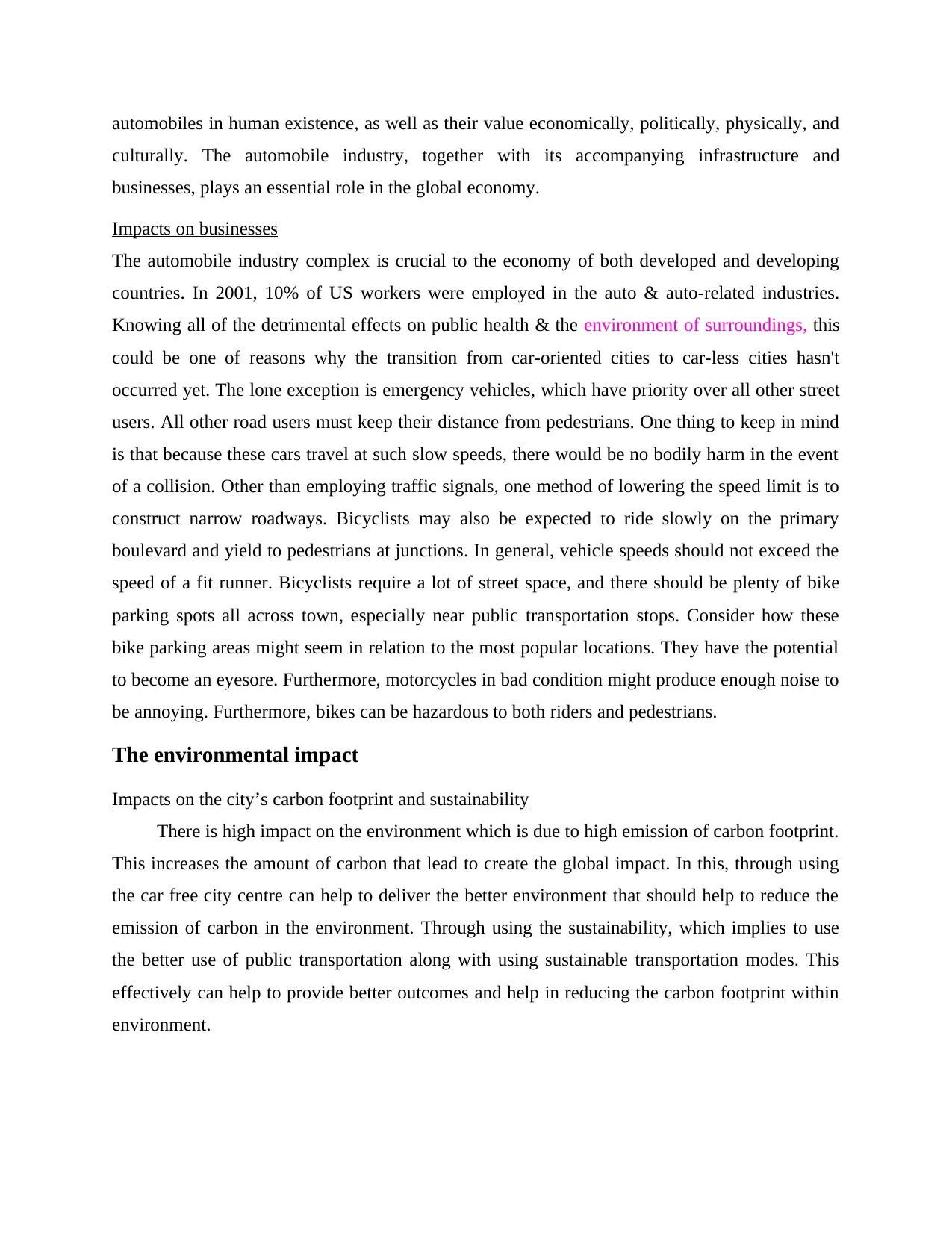
automobiles in human existence, as well as their value economically, politically, physically, and
culturally. The automobile industry, together with its accompanying infrastructure and
businesses, plays an essential role in the global economy.
Impacts on businesses
The automobile industry complex is crucial to the economy of both developed and developing
countries. In 2001, 10% of US workers were employed in the auto & auto-related industries.
Knowing all of the detrimental effects on public health & the environment of surroundings, this
could be one of reasons why the transition from car-oriented cities to car-less cities hasn't
occurred yet. The lone exception is emergency vehicles, which have priority over all other street
users. All other road users must keep their distance from pedestrians. One thing to keep in mind
is that because these cars travel at such slow speeds, there would be no bodily harm in the event
of a collision. Other than employing traffic signals, one method of lowering the speed limit is to
construct narrow roadways. Bicyclists may also be expected to ride slowly on the primary
boulevard and yield to pedestrians at junctions. In general, vehicle speeds should not exceed the
speed of a fit runner. Bicyclists require a lot of street space, and there should be plenty of bike
parking spots all across town, especially near public transportation stops. Consider how these
bike parking areas might seem in relation to the most popular locations. They have the potential
to become an eyesore. Furthermore, motorcycles in bad condition might produce enough noise to
be annoying. Furthermore, bikes can be hazardous to both riders and pedestrians.
The environmental impact
Impacts on the city’s carbon footprint and sustainability
There is high impact on the environment which is due to high emission of carbon footprint.
This increases the amount of carbon that lead to create the global impact. In this, through using
the car free city centre can help to deliver the better environment that should help to reduce the
emission of carbon in the environment. Through using the sustainability, which implies to use
the better use of public transportation along with using sustainable transportation modes. This
effectively can help to provide better outcomes and help in reducing the carbon footprint within
environment.
culturally. The automobile industry, together with its accompanying infrastructure and
businesses, plays an essential role in the global economy.
Impacts on businesses
The automobile industry complex is crucial to the economy of both developed and developing
countries. In 2001, 10% of US workers were employed in the auto & auto-related industries.
Knowing all of the detrimental effects on public health & the environment of surroundings, this
could be one of reasons why the transition from car-oriented cities to car-less cities hasn't
occurred yet. The lone exception is emergency vehicles, which have priority over all other street
users. All other road users must keep their distance from pedestrians. One thing to keep in mind
is that because these cars travel at such slow speeds, there would be no bodily harm in the event
of a collision. Other than employing traffic signals, one method of lowering the speed limit is to
construct narrow roadways. Bicyclists may also be expected to ride slowly on the primary
boulevard and yield to pedestrians at junctions. In general, vehicle speeds should not exceed the
speed of a fit runner. Bicyclists require a lot of street space, and there should be plenty of bike
parking spots all across town, especially near public transportation stops. Consider how these
bike parking areas might seem in relation to the most popular locations. They have the potential
to become an eyesore. Furthermore, motorcycles in bad condition might produce enough noise to
be annoying. Furthermore, bikes can be hazardous to both riders and pedestrians.
The environmental impact
Impacts on the city’s carbon footprint and sustainability
There is high impact on the environment which is due to high emission of carbon footprint.
This increases the amount of carbon that lead to create the global impact. In this, through using
the car free city centre can help to deliver the better environment that should help to reduce the
emission of carbon in the environment. Through using the sustainability, which implies to use
the better use of public transportation along with using sustainable transportation modes. This
effectively can help to provide better outcomes and help in reducing the carbon footprint within
environment.
Paraphrase This Document
Need a fresh take? Get an instant paraphrase of this document with our AI Paraphraser
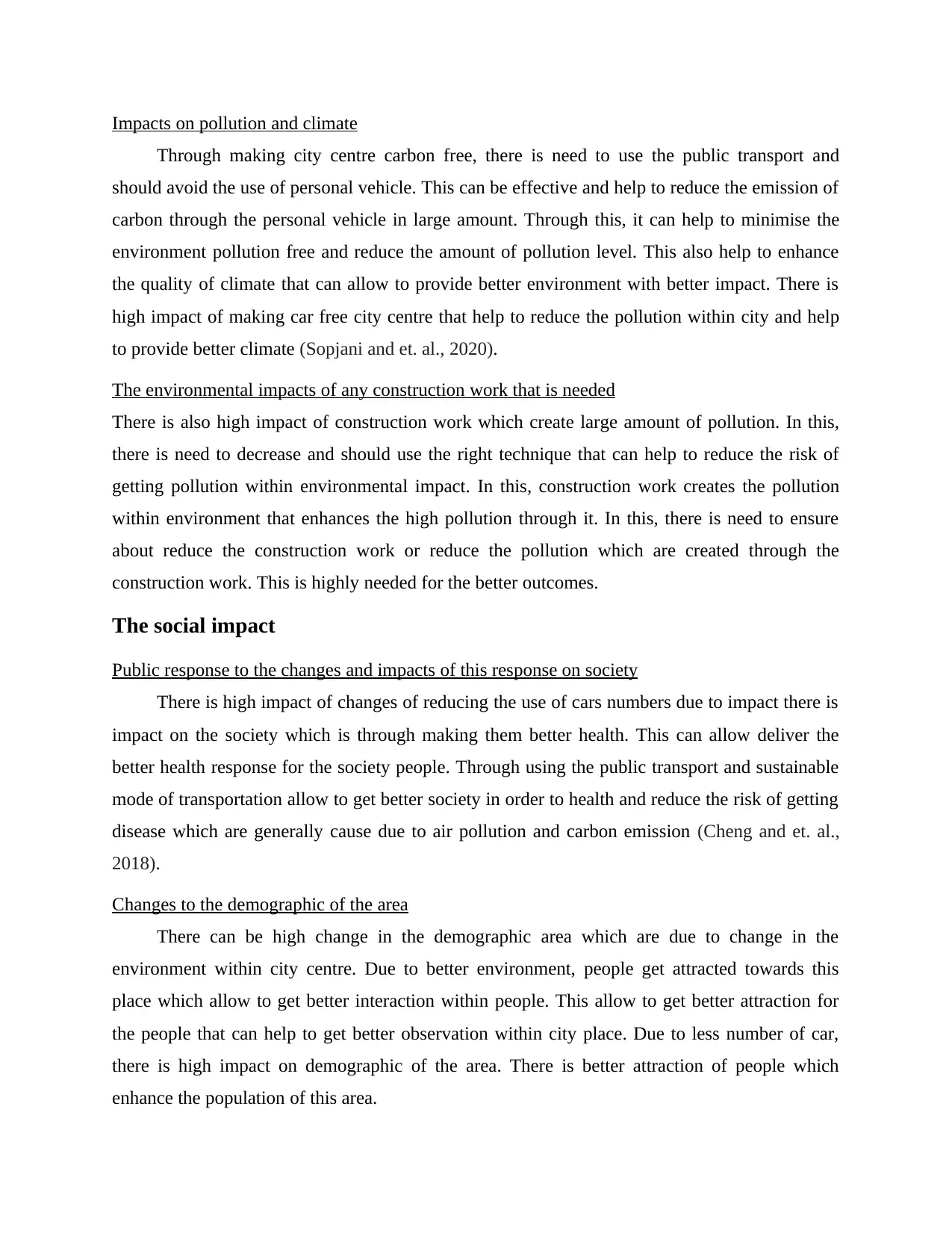
Impacts on pollution and climate
Through making city centre carbon free, there is need to use the public transport and
should avoid the use of personal vehicle. This can be effective and help to reduce the emission of
carbon through the personal vehicle in large amount. Through this, it can help to minimise the
environment pollution free and reduce the amount of pollution level. This also help to enhance
the quality of climate that can allow to provide better environment with better impact. There is
high impact of making car free city centre that help to reduce the pollution within city and help
to provide better climate (Sopjani and et. al., 2020).
The environmental impacts of any construction work that is needed
There is also high impact of construction work which create large amount of pollution. In this,
there is need to decrease and should use the right technique that can help to reduce the risk of
getting pollution within environmental impact. In this, construction work creates the pollution
within environment that enhances the high pollution through it. In this, there is need to ensure
about reduce the construction work or reduce the pollution which are created through the
construction work. This is highly needed for the better outcomes.
The social impact
Public response to the changes and impacts of this response on society
There is high impact of changes of reducing the use of cars numbers due to impact there is
impact on the society which is through making them better health. This can allow deliver the
better health response for the society people. Through using the public transport and sustainable
mode of transportation allow to get better society in order to health and reduce the risk of getting
disease which are generally cause due to air pollution and carbon emission (Cheng and et. al.,
2018).
Changes to the demographic of the area
There can be high change in the demographic area which are due to change in the
environment within city centre. Due to better environment, people get attracted towards this
place which allow to get better interaction within people. This allow to get better attraction for
the people that can help to get better observation within city place. Due to less number of car,
there is high impact on demographic of the area. There is better attraction of people which
enhance the population of this area.
Through making city centre carbon free, there is need to use the public transport and
should avoid the use of personal vehicle. This can be effective and help to reduce the emission of
carbon through the personal vehicle in large amount. Through this, it can help to minimise the
environment pollution free and reduce the amount of pollution level. This also help to enhance
the quality of climate that can allow to provide better environment with better impact. There is
high impact of making car free city centre that help to reduce the pollution within city and help
to provide better climate (Sopjani and et. al., 2020).
The environmental impacts of any construction work that is needed
There is also high impact of construction work which create large amount of pollution. In this,
there is need to decrease and should use the right technique that can help to reduce the risk of
getting pollution within environmental impact. In this, construction work creates the pollution
within environment that enhances the high pollution through it. In this, there is need to ensure
about reduce the construction work or reduce the pollution which are created through the
construction work. This is highly needed for the better outcomes.
The social impact
Public response to the changes and impacts of this response on society
There is high impact of changes of reducing the use of cars numbers due to impact there is
impact on the society which is through making them better health. This can allow deliver the
better health response for the society people. Through using the public transport and sustainable
mode of transportation allow to get better society in order to health and reduce the risk of getting
disease which are generally cause due to air pollution and carbon emission (Cheng and et. al.,
2018).
Changes to the demographic of the area
There can be high change in the demographic area which are due to change in the
environment within city centre. Due to better environment, people get attracted towards this
place which allow to get better interaction within people. This allow to get better attraction for
the people that can help to get better observation within city place. Due to less number of car,
there is high impact on demographic of the area. There is better attraction of people which
enhance the population of this area.
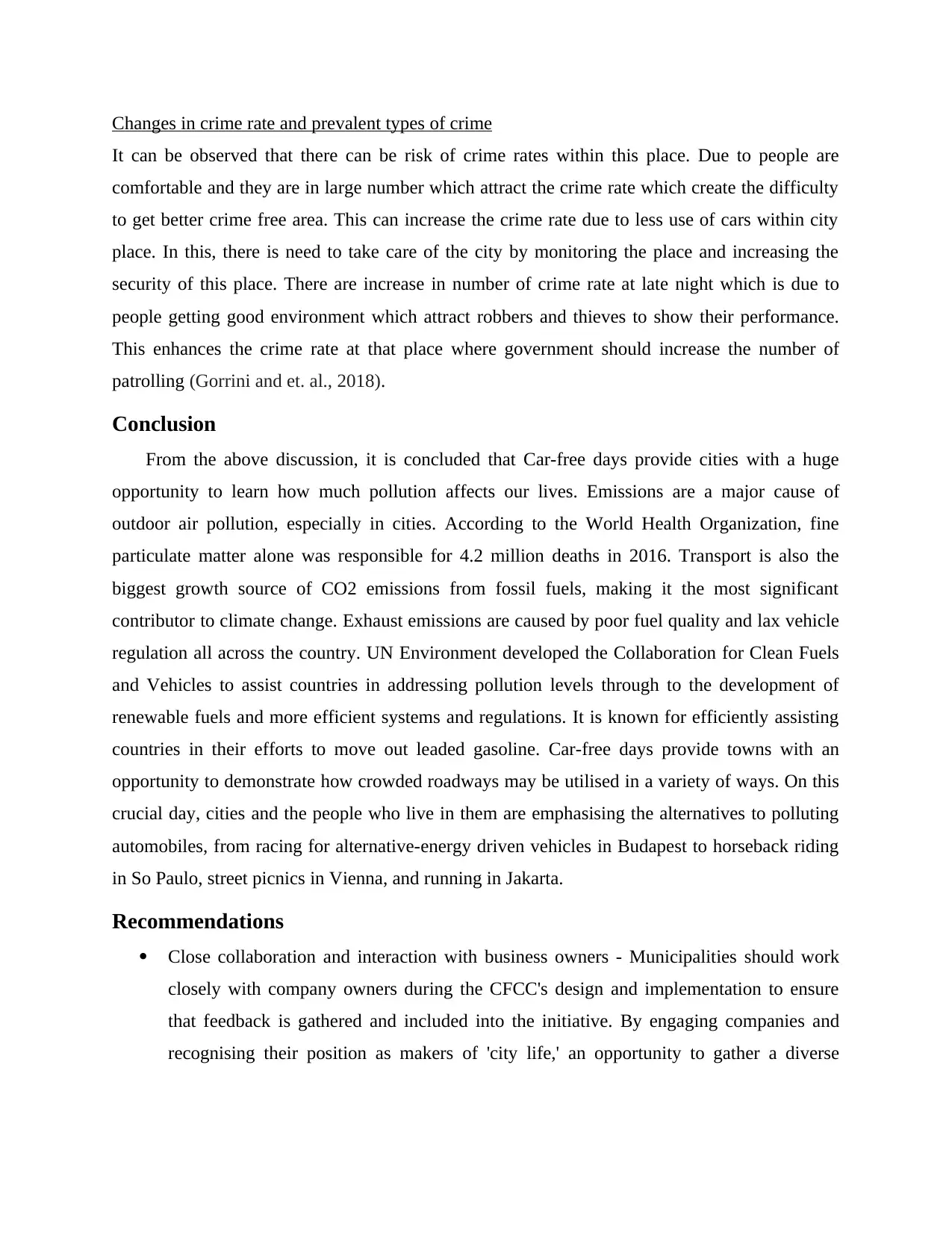
Changes in crime rate and prevalent types of crime
It can be observed that there can be risk of crime rates within this place. Due to people are
comfortable and they are in large number which attract the crime rate which create the difficulty
to get better crime free area. This can increase the crime rate due to less use of cars within city
place. In this, there is need to take care of the city by monitoring the place and increasing the
security of this place. There are increase in number of crime rate at late night which is due to
people getting good environment which attract robbers and thieves to show their performance.
This enhances the crime rate at that place where government should increase the number of
patrolling (Gorrini and et. al., 2018).
Conclusion
From the above discussion, it is concluded that Car-free days provide cities with a huge
opportunity to learn how much pollution affects our lives. Emissions are a major cause of
outdoor air pollution, especially in cities. According to the World Health Organization, fine
particulate matter alone was responsible for 4.2 million deaths in 2016. Transport is also the
biggest growth source of CO2 emissions from fossil fuels, making it the most significant
contributor to climate change. Exhaust emissions are caused by poor fuel quality and lax vehicle
regulation all across the country. UN Environment developed the Collaboration for Clean Fuels
and Vehicles to assist countries in addressing pollution levels through to the development of
renewable fuels and more efficient systems and regulations. It is known for efficiently assisting
countries in their efforts to move out leaded gasoline. Car-free days provide towns with an
opportunity to demonstrate how crowded roadways may be utilised in a variety of ways. On this
crucial day, cities and the people who live in them are emphasising the alternatives to polluting
automobiles, from racing for alternative-energy driven vehicles in Budapest to horseback riding
in So Paulo, street picnics in Vienna, and running in Jakarta.
Recommendations
Close collaboration and interaction with business owners - Municipalities should work
closely with company owners during the CFCC's design and implementation to ensure
that feedback is gathered and included into the initiative. By engaging companies and
recognising their position as makers of 'city life,' an opportunity to gather a diverse
It can be observed that there can be risk of crime rates within this place. Due to people are
comfortable and they are in large number which attract the crime rate which create the difficulty
to get better crime free area. This can increase the crime rate due to less use of cars within city
place. In this, there is need to take care of the city by monitoring the place and increasing the
security of this place. There are increase in number of crime rate at late night which is due to
people getting good environment which attract robbers and thieves to show their performance.
This enhances the crime rate at that place where government should increase the number of
patrolling (Gorrini and et. al., 2018).
Conclusion
From the above discussion, it is concluded that Car-free days provide cities with a huge
opportunity to learn how much pollution affects our lives. Emissions are a major cause of
outdoor air pollution, especially in cities. According to the World Health Organization, fine
particulate matter alone was responsible for 4.2 million deaths in 2016. Transport is also the
biggest growth source of CO2 emissions from fossil fuels, making it the most significant
contributor to climate change. Exhaust emissions are caused by poor fuel quality and lax vehicle
regulation all across the country. UN Environment developed the Collaboration for Clean Fuels
and Vehicles to assist countries in addressing pollution levels through to the development of
renewable fuels and more efficient systems and regulations. It is known for efficiently assisting
countries in their efforts to move out leaded gasoline. Car-free days provide towns with an
opportunity to demonstrate how crowded roadways may be utilised in a variety of ways. On this
crucial day, cities and the people who live in them are emphasising the alternatives to polluting
automobiles, from racing for alternative-energy driven vehicles in Budapest to horseback riding
in So Paulo, street picnics in Vienna, and running in Jakarta.
Recommendations
Close collaboration and interaction with business owners - Municipalities should work
closely with company owners during the CFCC's design and implementation to ensure
that feedback is gathered and included into the initiative. By engaging companies and
recognising their position as makers of 'city life,' an opportunity to gather a diverse
⊘ This is a preview!⊘
Do you want full access?
Subscribe today to unlock all pages.

Trusted by 1+ million students worldwide
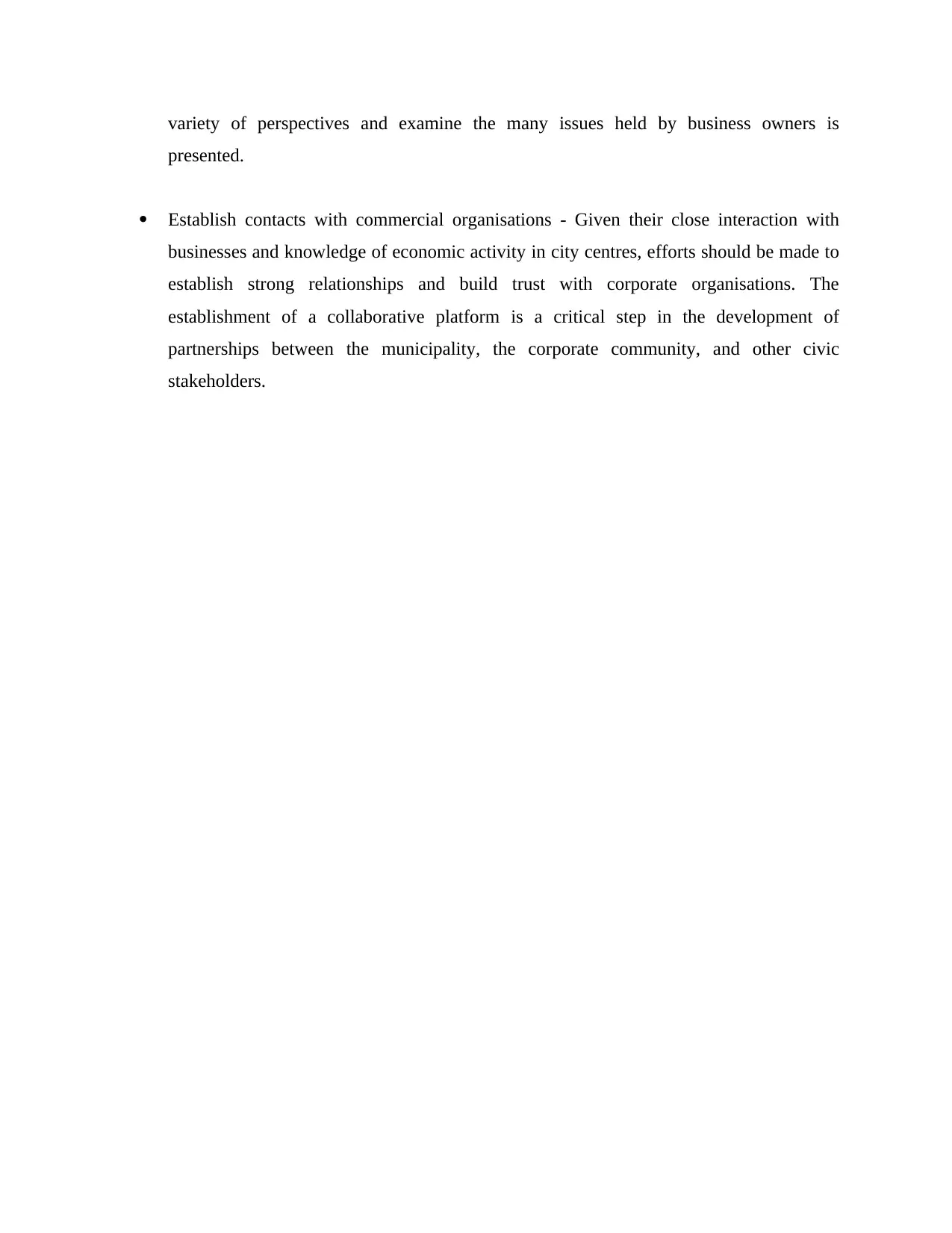
variety of perspectives and examine the many issues held by business owners is
presented.
Establish contacts with commercial organisations - Given their close interaction with
businesses and knowledge of economic activity in city centres, efforts should be made to
establish strong relationships and build trust with corporate organisations. The
establishment of a collaborative platform is a critical step in the development of
partnerships between the municipality, the corporate community, and other civic
stakeholders.
presented.
Establish contacts with commercial organisations - Given their close interaction with
businesses and knowledge of economic activity in city centres, efforts should be made to
establish strong relationships and build trust with corporate organisations. The
establishment of a collaborative platform is a critical step in the development of
partnerships between the municipality, the corporate community, and other civic
stakeholders.
Paraphrase This Document
Need a fresh take? Get an instant paraphrase of this document with our AI Paraphraser
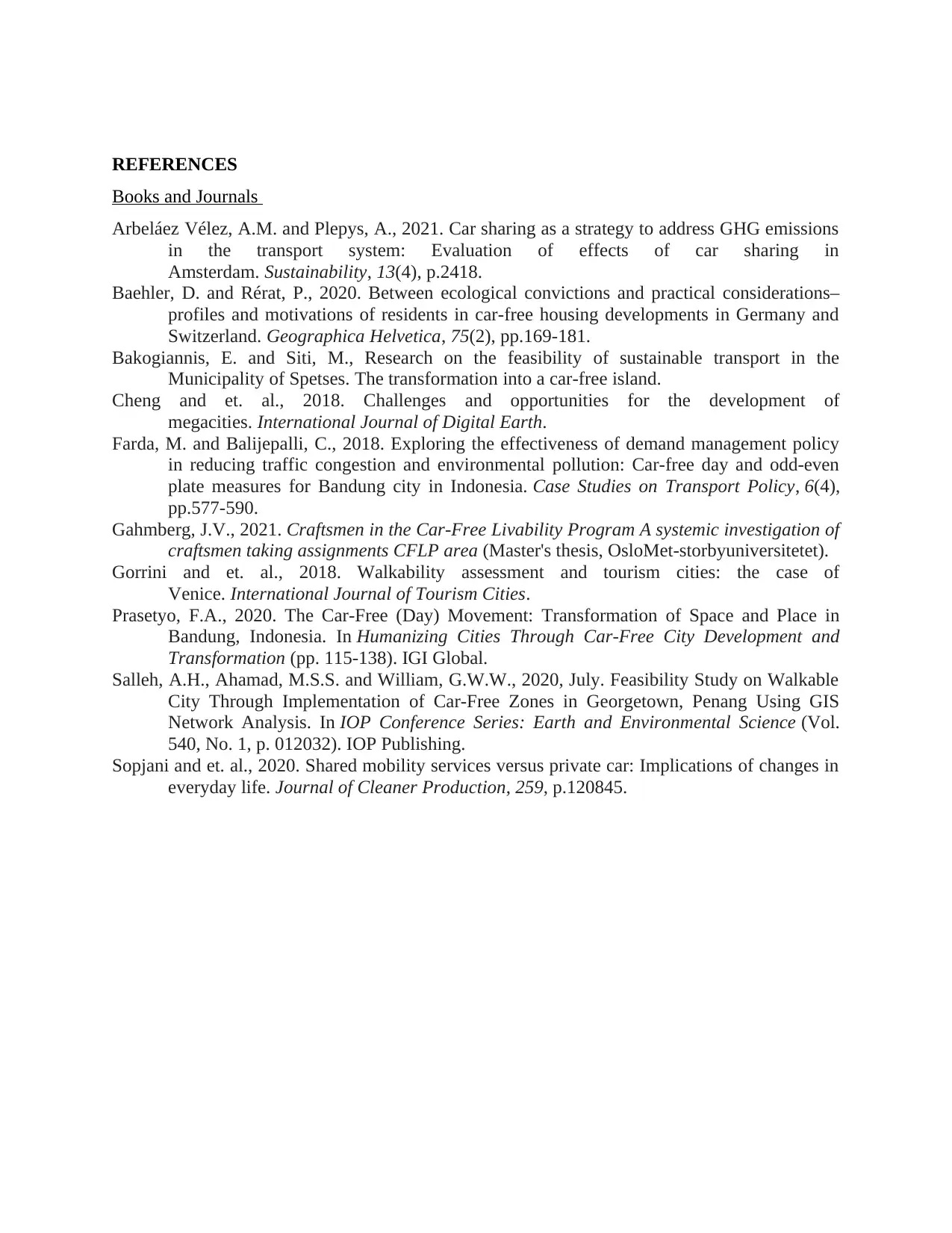
REFERENCES
Books and Journals
Arbeláez Vélez, A.M. and Plepys, A., 2021. Car sharing as a strategy to address GHG emissions
in the transport system: Evaluation of effects of car sharing in
Amsterdam. Sustainability, 13(4), p.2418.
Baehler, D. and Rérat, P., 2020. Between ecological convictions and practical considerations–
profiles and motivations of residents in car-free housing developments in Germany and
Switzerland. Geographica Helvetica, 75(2), pp.169-181.
Bakogiannis, E. and Siti, M., Research on the feasibility of sustainable transport in the
Municipality of Spetses. The transformation into a car-free island.
Cheng and et. al., 2018. Challenges and opportunities for the development of
megacities. International Journal of Digital Earth.
Farda, M. and Balijepalli, C., 2018. Exploring the effectiveness of demand management policy
in reducing traffic congestion and environmental pollution: Car-free day and odd-even
plate measures for Bandung city in Indonesia. Case Studies on Transport Policy, 6(4),
pp.577-590.
Gahmberg, J.V., 2021. Craftsmen in the Car-Free Livability Program A systemic investigation of
craftsmen taking assignments CFLP area (Master's thesis, OsloMet-storbyuniversitetet).
Gorrini and et. al., 2018. Walkability assessment and tourism cities: the case of
Venice. International Journal of Tourism Cities.
Prasetyo, F.A., 2020. The Car-Free (Day) Movement: Transformation of Space and Place in
Bandung, Indonesia. In Humanizing Cities Through Car-Free City Development and
Transformation (pp. 115-138). IGI Global.
Salleh, A.H., Ahamad, M.S.S. and William, G.W.W., 2020, July. Feasibility Study on Walkable
City Through Implementation of Car-Free Zones in Georgetown, Penang Using GIS
Network Analysis. In IOP Conference Series: Earth and Environmental Science (Vol.
540, No. 1, p. 012032). IOP Publishing.
Sopjani and et. al., 2020. Shared mobility services versus private car: Implications of changes in
everyday life. Journal of Cleaner Production, 259, p.120845.
Books and Journals
Arbeláez Vélez, A.M. and Plepys, A., 2021. Car sharing as a strategy to address GHG emissions
in the transport system: Evaluation of effects of car sharing in
Amsterdam. Sustainability, 13(4), p.2418.
Baehler, D. and Rérat, P., 2020. Between ecological convictions and practical considerations–
profiles and motivations of residents in car-free housing developments in Germany and
Switzerland. Geographica Helvetica, 75(2), pp.169-181.
Bakogiannis, E. and Siti, M., Research on the feasibility of sustainable transport in the
Municipality of Spetses. The transformation into a car-free island.
Cheng and et. al., 2018. Challenges and opportunities for the development of
megacities. International Journal of Digital Earth.
Farda, M. and Balijepalli, C., 2018. Exploring the effectiveness of demand management policy
in reducing traffic congestion and environmental pollution: Car-free day and odd-even
plate measures for Bandung city in Indonesia. Case Studies on Transport Policy, 6(4),
pp.577-590.
Gahmberg, J.V., 2021. Craftsmen in the Car-Free Livability Program A systemic investigation of
craftsmen taking assignments CFLP area (Master's thesis, OsloMet-storbyuniversitetet).
Gorrini and et. al., 2018. Walkability assessment and tourism cities: the case of
Venice. International Journal of Tourism Cities.
Prasetyo, F.A., 2020. The Car-Free (Day) Movement: Transformation of Space and Place in
Bandung, Indonesia. In Humanizing Cities Through Car-Free City Development and
Transformation (pp. 115-138). IGI Global.
Salleh, A.H., Ahamad, M.S.S. and William, G.W.W., 2020, July. Feasibility Study on Walkable
City Through Implementation of Car-Free Zones in Georgetown, Penang Using GIS
Network Analysis. In IOP Conference Series: Earth and Environmental Science (Vol.
540, No. 1, p. 012032). IOP Publishing.
Sopjani and et. al., 2020. Shared mobility services versus private car: Implications of changes in
everyday life. Journal of Cleaner Production, 259, p.120845.
1 out of 11
Related Documents
Your All-in-One AI-Powered Toolkit for Academic Success.
+13062052269
info@desklib.com
Available 24*7 on WhatsApp / Email
![[object Object]](/_next/static/media/star-bottom.7253800d.svg)
Unlock your academic potential
Copyright © 2020–2025 A2Z Services. All Rights Reserved. Developed and managed by ZUCOL.



